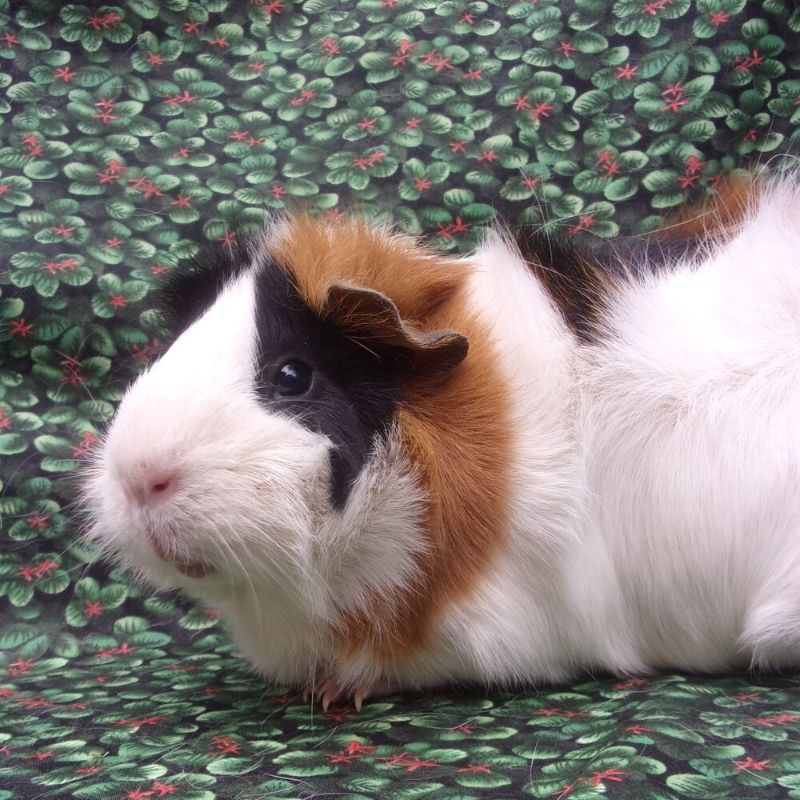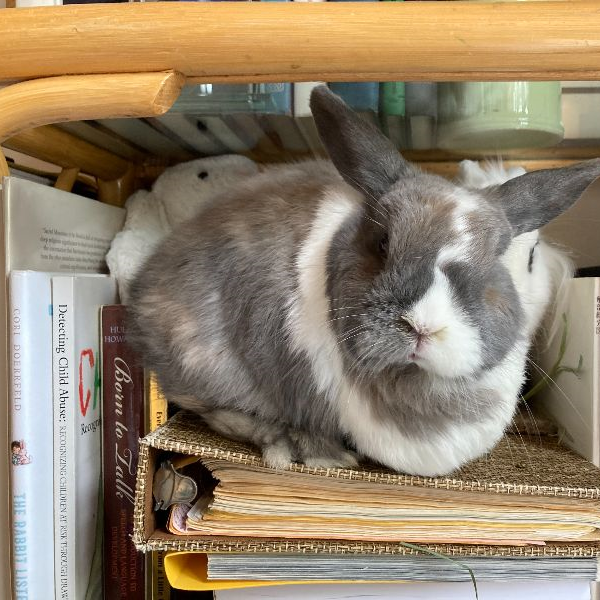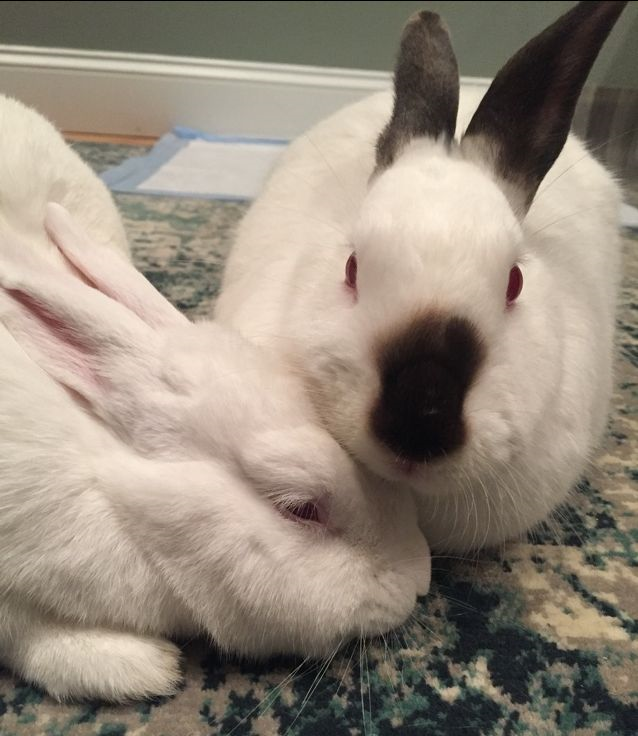The Carrot Tribune - May 2021
In this issue...
Guinea Pig of the Month
Luna Finds a Home with Suki
Moving with Rabbits?!
BUNS is closed to the public due to Covid-19. We're looking forward to reopening the shelter, restarting Hoppy Hour, and holding Basic Bunny and Guinea Pig classes again. Until it's safe to do so, we are here for the rabbits and guinea pigs and for bunny and piggie parents.
Guinea Pig of the Month
Petunia is a mature and composed lady piggy with wonderful manners and a calm disposition. She is very comfortable with humans, and really appreciates pets and cuddles. She is a wonderful Abyssinian breed girl with lovely coat and color. Petunia is looking for her forever home with a loving adopter and plenty of treats!
Luna Finds a Home with Suki
Editor's note: This story was contributed by BUNS volunteer Marlene
Luna Finds a Home with Suki
Editor's note: This story was contributed by BUNS volunteer Marlene
Suki, a beautiful, sweet, and smart Dutch rabbit, was adopted by me four years ago. BUNS had her malocclusion fixed so she had no front teeth, but she had a lot of brain power. In five minutes my daughter had clicker-trained her to sit up and spin in a circle. Now she can knock down tubes, jump through a hoop or over legs (all for a treat of course!). Everything seemed wonderful but she seemed a little lonely in spite of all our love and affection. Rabbits need other rabbits!!
Luna, a very curious and spirited Hotot/Lionhead mix, was brought into BUNS from the streets of Isla Vista. She had to be smart to survive that! And since Luna also had to have her front teeth removed they seemed a match made in bunny heaven.
Suki did not like her territory being invaded by another female rabbit. Over time and with a lot of bonding help from BUNS they have become the best of friends.
Moving with rabbits?!
Editor's note: this story was contributed by BUNS volunteer Dana
Moving house is stressful in general, but moving with rabbits adds another layer. When we were preparing to move cross-country (California to Massachusetts), our pets (4 rabbits, 1 cat, and 1 leopard gecko) were my biggest source of anxiety. After doing some research on it, I learned that moving is a huge reason why pets are surrendered at shelters. Sometimes owners’ new homes don’t accept pets, or the owners don’t think their pets will be able to handle it. We would never dream of leaving our pets behind if we had any say in the matter, but I was especially worried about the stress of the journey, as one of my bunnies is 12 years old! I can happily tell you now we did it, and I was very impressed with how well our pets handled it. They are all very happy now in our new home!
One of the first big decisions we had to make was whether to fly or drive. The benefit of flying was that it would be shorter travel time overall. But it would require two trips to get all the pets there (very limited airlines even allow rabbits in the cabin, and those that do don’t allow more than 2 rabbits per passenger), and we would have much less control over the situation if a problem occurred. Our vet asked what we would do if we got stranded in an airport overnight with the pets (in the middle of a pandemic, no less), a horrifying thought! Driving takes longer, but you have much more control over the situation. Most rabbits are also at least somewhat used to traveling in a car, but most have never been on a plane, so you don’t know how they will react to the pressure changes or new sounds. So, we decided driving was the right move. Whether you decide to drive or fly will likely depend on how far you are going, how many rabbits you have, and what your vet recommends!
Before our trip, all of the pets had a check-up with our vet, and she set us up with first-aid supplies we might need on the journey: Metacam, gabapentin (in case anyone got overly stressed), lactated ringers (subcutaneous fluids), and plenty of recovery food and syringes. We also had some oral fluids (lots of bunny owners use Pedialyte, and there are some bunny-specific products out there now), and simethicone. If you’ve never given subcutaneous fluids, your vet can show you how to do it. All of these things are good to have in your bunny first-aid kit anyway! We brought along lots of favorite hay from home, and a cooler so we could have fresh greens on hand (we bought some along the way as well).
We planned out our route to reduce the risks of hitting bad weather (we were driving in early March) and booked rooms at La Quinta Inns along the way. They are known to be pet friendly, and their room set-ups worked very well! Many had large tiled areas, so we could set up x-pens for the bunnies and not have to worry about the carpet.
The journey took 6 days, and we ended up driving 6-12 hours each day, including a longer break halfway through the day (usually around 45 min). In retrospect the 12 hour day was too long, but 8-9 hours was very manageable. Most of our days were around 8 hours. The buns were in carriers (1 pair per carrier) that had a layer of pine pellet bedding with hay on top. I had water crocks clipped to the doors with a little water in them. Some of the buns did drink a bit during the day and on breaks. During the breaks I offered the buns favorite wet greens, which usually they would nibble on eventually. We stopped a few times at supermarkets to get different types of herbs to entice them (parsley, kale, and carrot tops were usually the winners!). It usually took at least 20 minutes for them to calm down enough to eat. On a couple occasions I had to give a bunny some recovery food during the break, but thankfully with some banana mashed in she ate it willingly. It would have been a huge hassle to try to actually syringe feed her in the car, but I was prepared to do it if necessary! My main goal was to make sure the rabbits ate SOMETHING every 4-6 hours, even if just a few bites.
Each evening we would set the buns up in the motel, and give them their salad and lots of hay. Getting the luggage cart from the motel was essential, as we had tons of stuff (3 crates, two x-pens, a big tote of hay, litter boxes, etc.). Usually, they would start eating hay right away and would run around exploring and stretching their legs. The first night I used pee-pads, but found they seemed happier and ate more when they had their actual litter box filled with hay. They also seemed very happy to have their favorite chew toys. In the morning, we would sweep the room very well after loading everyone back into the car and take out the trash to the dumpster. We didn’t have any issues with the motels!
One bunny, Myra, did need some extra supportive care. After about the second day, she didn’t have a great appetite, so I ended up syringe feeding her, giving Metacam, and giving oral fluids morning and evening, basically for the rest of the trip. I also gave her and another bunny subcutaneous fluids on one evening after a very long day of driving (too long, in retrospect). Myra would always eat on the breaks in the car, so I think either she didn’t feel comfortable being in unfamiliar places, she was anticipating the driving, or the medicines helped her feel better. I think if our trip had been any longer, I would have taken a full day break at some point just to let everyone rest. Surprisingly, my 12 year-old bun handled it like a champ! He wouldn’t eat when the car was moving, but always ate on the breaks and behaved normally in the hotel.
Overall it went much better than I expected. Not to say I want to do it again anytime soon… but if you prepare properly it can be done without too much stress!



